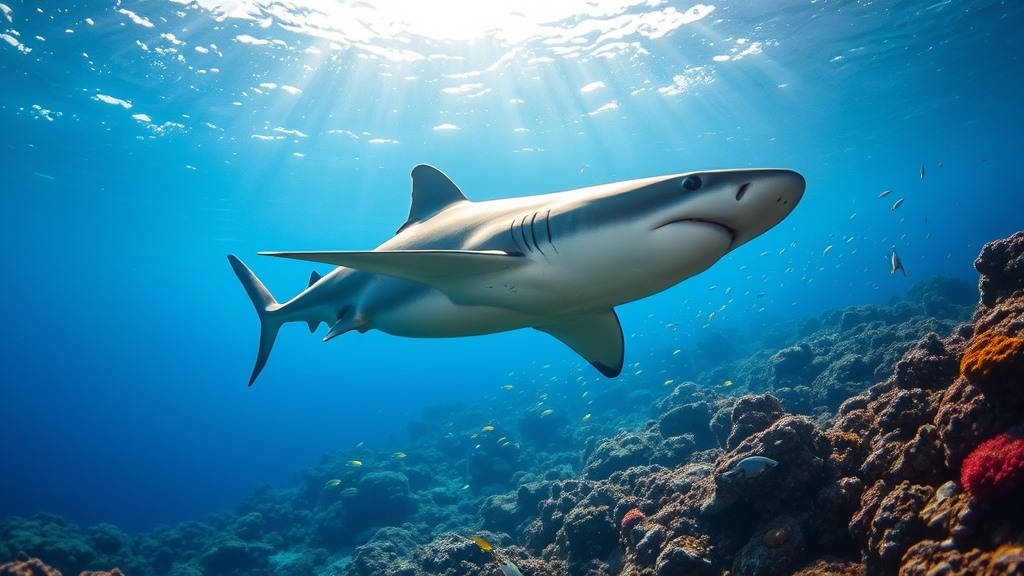Sharks are often misunderstood, but they play a crucial role in ocean health. They help control populations of prey, preventing overgrowth and maintaining balance within marine ecosystems. Without sharks, mid-level predators can explode in numbers, leading to imbalances that threaten other species. Protecting sharks is vital for biodiversity and overall ocean stability. If you want to learn more about their essential role, keep exploring how these predators support healthy oceans.
Key Takeaways
- Sharks regulate marine populations, maintaining balanced predator-prey relationships essential for healthy ecosystems.
- Their decline causes overpopulation of mid-level predators, disrupting food chains and biodiversity.
- Sharks help prevent the spread of disease by preying on weak or sick animals.
- They act as ecological filters, supporting species diversity and overall ocean health.
- Conservation efforts like protected areas are vital to preserving sharks’ ecological roles.

Despite their reputation as fierce predators, sharks are often misunderstood and unfairly feared. Many people see them as mindless killers, but in reality, sharks play a fundamental role in maintaining the health of ocean ecosystems. Their presence helps regulate predator prey dynamics, guaranteeing that fish populations and other marine life remain balanced. Without sharks, these systems could become destabilized, leading to overpopulation of certain species and the decline of others, which ultimately affects the entire marine food chain. Protecting sharks isn’t just about saving individual animals; it’s about preserving the intricate web of life beneath the waves. Effective fraud prevention tools such as multi-factor authentication and machine learning algorithms can help mitigate threats to financial transactions, similar to how predators help regulate populations in nature.
Sharks are vital for ocean health, balancing ecosystems and preserving marine life.
Shark conservation efforts are essential because these predators are vulnerable to numerous threats, including overfishing, habitat loss, and pollution. As humans continue to fish unsustainably, shark populations decline at alarming rates, disturbing predator prey dynamics and threatening the health of the ocean. When sharks are removed from their ecosystems in large numbers, the imbalance can lead to the proliferation of mid-level predators, which then overconsume smaller fish and invertebrates. This cascade effect illustrates just how interconnected marine life truly is, emphasizing the importance of safeguarding sharks to maintain ecological stability. Recognizing the ecological importance of sharks helps us understand why their preservation is vital for ocean health. Additionally, conservation strategies such as international agreements and community engagement are critical components of effective shark protection policies.
You might not realize it, but sharks help keep the ocean’s food web in check. By preying on the sick, weak, or slow-moving animals, they help ensure healthier populations of prey species. This natural selection process prevents disease spread and keeps prey populations robust. Additionally, sharks often target the most abundant prey, preventing any single species from dominating the ecosystem. Their role in predator prey dynamics acts as a natural filter, promoting biodiversity and resilience in ocean habitats. When sharks thrive, the entire ecosystem benefits, supporting fisheries, tourism, and the overall health of our planet. Moreover, marine protected areas are critical for providing safe habitats where sharks can feed, breed, and recover, further supporting their ecological role. Protecting these areas ensures that sharks can continue fulfilling their vital functions without disturbance.
Frequently Asked Questions
How Do Sharks Communicate With Each Other Underwater?
You might wonder how sharks communicate underwater. They use various underwater communication methods, including shark acoustic signals, which are sounds they produce to alert others or establish territory. Sharks also detect vibrations and electrical fields with their specialized senses, allowing them to stay aware of nearby peers. These methods help them coordinate hunting, avoid danger, and socialize, making shark acoustic signals and other communication techniques essential for their survival beneath the ocean’s surface.
What Is the Average Lifespan of Different Shark Species?
You might be surprised to learn that shark lifespans vary widely among species. For example, great white sharks live up to 70 years, while smaller species like the spiny dogfish live about 20 years. During their long lives, they undertake impressive shark migration journeys and adapt their dietary habits. Understanding these lifespans helps you appreciate sharks’ roles in maintaining healthy ocean ecosystems, highlighting their importance beyond just their fierce reputation.
Are There Any Conservation Programs Successfully Protecting Sharks?
You’ll find that several conservation programs are making progress in protecting sharks. Initiatives focus on sustainable fishing practices and establishing marine protected areas, which help reduce bycatch and habitat destruction. These efforts involve governments, NGOs, and local communities working together to guarantee shark populations recover and thrive. By supporting these programs, you contribute to healthier oceans and the essential role sharks play in maintaining marine ecosystems.
How Do Sharks Reproduce and Care for Their Young?
When it comes to shark reproduction, you should know that shark mating involves complex behaviors where males and females engage in courtship. Sharks produce pups through oviparity, viviparity, or ovoviviparity, depending on the species. For pup survival, sharks use strategies like live birth or laying eggs in protected areas. These survival strategies are critical, ensuring the next generation of sharks thrives in their ocean habitats.
What Are the Signs of a Healthy Shark Population?
You can tell a healthy shark population by observing consistent shark migration patterns and diverse shark feeding behavior. Healthy populations show stable numbers, regular seasonal movements, and active feeding, indicating they’re thriving. If you see a wide range of sizes and species, it’s a good sign their reproductive success supports their numbers. Such signs reflect balanced ecosystems, highlighting sharks’ essential role in maintaining ocean health.
Conclusion
You might think sharks are dangerous and unnecessary, but they actually play a crucial role in maintaining healthy oceans. Without them, ecosystems could become unbalanced, leading to the collapse of many marine species. So, next time you see a shark, remember they’re not the villains but essential predators that keep our oceans thriving. Protecting sharks means safeguarding the entire underwater world you love—because when they thrive, so do we all.









